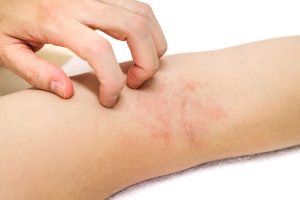10 eczema facts
In this article we will describe 10 facts about eczema.
5 Key Points
-
Eczema is a chronic inflammatory skin condition characterised by dry, itchy, and scaly skin.
-
Prevalence in the UK is approximately 15-20% in children and 5-10% in adults – i.e very common
-
Atopic eczema is the most common type, often associated with asthma and allergies.
-
Diagnosis is primarily clinical, with investigations reserved for uncertain cases or severe disease.
-
Treatment focuses on topical corticosteroids, moisturisers, and lifestyle modifications.
1. Definition
- Eczema, also known as atopic dermatitis, is a chronic or recurrent inflammatory skin condition marked by dryness, itching, and scaling.
- The term ‘eczema’ encompasses various clinical entities, including atopic, contact, seborrhoeic, and nummular eczema.
Types
-
Atopic Eczema: Most common type, often associated with asthma, allergies, and family history.
-
Contact Dermatitis: Caused by skin contact with irritants or allergens.
-
Seborrhoeic Eczema: Typically affects oily areas, such as scalp, face, and chest.
-
Nummular Eczema: Coin-shaped patches, often on legs.
-
Dyshidrotic Eczema: Vesicular lesions on palms and soles.
2. Epidemiology
-
Prevalence in UK children: 15-20%.
-
Prevalence in UK adults: 5-10%.
-
Higher incidence in urban areas and developed countries.
-
Increased prevalence in families with atopic diseases.
3. Risk Factors
-
Family history of eczema, asthma, or allergies.
-
Urban residence.
-
Developed country.
-
Hygiene hypothesis (reduced exposure to childhood infections).
-
Genetic predisposition.
4. Causes
-
Genetic factors.
-
Environmental triggers (allergens, irritants, stress).
-
Imbalanced immune response.
-
Skin barrier dysfunction.
5. Symptoms
-
Dry, scaly, or cracked skin – especially on flexor surfaces (front of elbow, back of knee).
-
Intense itching (pruritus).
-
Redness and inflammation.
-
Skin thickening (lichenification).
-
Papules, vesicles, or pustules.
 Typical flexural (i.e. in the creases) eczema
Typical flexural (i.e. in the creases) eczema
6. Diagnosis
Primarily clinical, based on:
-
History.
-
Physical examination.
-
Symptom severity.
Investigation
Reserved for:
-
Uncertain diagnosis.
-
Severe disease.
-
Suspected allergies or infections.
Investigations may include:
-
Skin prick testing.
-
Patch testing.
-
Blood tests (IgE, eosinophils).
-
Skin scraping or biopsy.
Differential Diagnosis
-
Psoriasis.
-
Dermatitis herpetiformis.
-
Ichthyosis.
-
Allergic contact dermatitis.
-
Scabies.
7. Treatment
-
Topical Corticosteroids: First-line treatment for inflammation.
-
Moisturisers: Emollients and humectants for dry skin.
-
Topical Immunomodulators: For severe or recalcitrant cases.
-
Antibiotics: For secondary infections.
-
Lifestyle Modifications:
-
Avoid soaps and harsh cleansers.
-
Wear breathable clothing.
-
Maintain skin hydration.
-
Control anxiety.
-
When to see a doctor with eczema
-
Initial diagnosis.
-
Severe or worsening symptoms.
-
Poor response to treatment.
-
Suspected complications (e.g. skin infections).
-
Consider referral to dermatology for severe or complex cases.
8. Complications
-
Secondary skin infections (bacterial, viral, or fungal).
-
Eczema herpeticum (widespread viral infection)
-
Lichenification and skin thickening.
-
Mental health impacts (anxiety, depression).
9. Prognosis
-
Variable disease course.
-
Remissions and exacerbations common.
-
Early intervention and adherence to treatment improve outcomes.
10. Prevention
-
Breastfeeding and maternal avoidance of allergenic foods.
-
Early introduction of solids.
-
Avoidance of soaps and harsh cleansers.
-
Regular moisturising.
-
Stress management.
Summary
We have described 10 facts about eczema. We hope it has been helpful.

